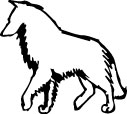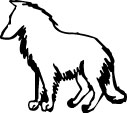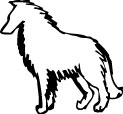Shaping as a training technique.
Debby Boehm
|
Shaping the dog to free stack.
Explanation: It is much easier to maintain a dog's animation by utilizing shaping as a training technique than it is to try to teach a dog to act animated after other methods have shattered its confidence. The more a dog is corrected, the less self-confident it will become. Molding is the technique most commonly used. This process requires that the trainer manually move the dog into the desired position. Most dogs and puppies will resist any attempt to hold them in place. Often, the more a pup is held, the more he will squirm. All this squirming and fighting interferes with learning, damages the self-confidence and decreases animation. This is especially important when applied to dogs that for the first time are experiencing the socialization that is part of the preparation for a show career. A much easier approach involves shaping.
Shaping is the reinforcement of approximations. This means the target behaviour (the dog standing square, baiting) is broken down into small increments which are easily achieved, facilitation errorless learning. Each step is almost a sure correct response so minimal (if any) corrections are required. The dog's confidence remains at its maximum level, possibly making the difference between the dog that baits and a dog that shows.
|
 Goal: To train a dog to free bait standing square on its feet, exhibiting maximum animation while maintaining a high degree of obedience. Goal: To train a dog to free bait standing square on its feet, exhibiting maximum animation while maintaining a high degree of obedience. |
| Shaping the stand: After one step is mastered, progress to the next. Move at your dogs' own speed. |
 Method: Method:
Step 1- Reward the dog for baiting, ears up showing a high degree of animation. The position of the dog is not important at this stage.
|
 Step 2- Reward the dog for baiting and standing still. This means the dog will receive bait only while it is standing still, not after it has broken the stand. Initially the dog will only stand for a few seconds to be rewarded, but as training progresses, the stand stay will be required for gradually longer periods of time. At this step, it is important that the dog learn not to move while being baited: how it is standing is not important. Step 2- Reward the dog for baiting and standing still. This means the dog will receive bait only while it is standing still, not after it has broken the stand. Initially the dog will only stand for a few seconds to be rewarded, but as training progresses, the stand stay will be required for gradually longer periods of time. At this step, it is important that the dog learn not to move while being baited: how it is standing is not important. |
| Release: After the dog has posed correctly and received a reward, release him with an 'O.K.'. Use of a release work defines when the dog is under command and when it is not. |
| Correction: If the dog should step forward breaking the stand stay prior to your release, execute a correction by walking into the dog, causing him to back up. |
 Step 3- Most dogs will stand with their hind legs slightly under themselves. Teaching them to take a step with their front feet helps square them up and distributes the weight evenly on all four feet. Step 3- Most dogs will stand with their hind legs slightly under themselves. Teaching them to take a step with their front feet helps square them up and distributes the weight evenly on all four feet. |
 Step 3- After 'Step up' on one side. Step 3- After 'Step up' on one side. |
| Use your hand, or use the lead and collar to shift the dogs weight by pushing on the side of his neck just above the shoulder. As the weight is pushed to one side, the foot on the other side steps forward to compensate for the shift off balance. Command 'Take a step' then shift the dogs weight to one side, as the dog steps up release your pressure then reward the dog with a piece of bait. With practice you can drop the foot exactly where you want by releasing the 'push' at the proper moment. Practice this with both front feet. |
| Step 4- Require that the dog step up with both feet prior to receiving reinforcement. |
| Step 5- Practice backing away from the dog one small step at a time. Correct as previously described if the dog breaks the stay. |
| Originally published 1980, 1981 in the Advocate, magazine of the Owner Handler Association of America, INC. |
|
|